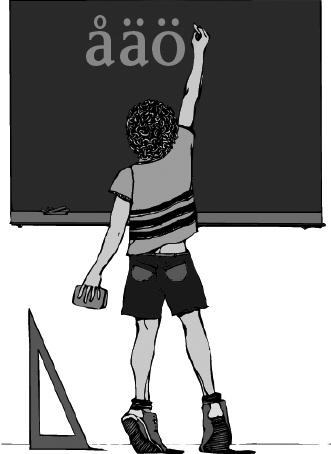Lär dig svenska / Study Swedish
-

-
-
‘Sjutusensjuhundrasjuttiosju Sjösjuka Sjömän..."
-

-
-
So you want to learn Swedish?
-
Whether you want to be able to say a few niceties to your in-laws from Sweden or be able to converse fluently in the language of Björn Borg and Ingmar Bergman, there are many ways to go about the business of learning Swedish. What it boils down to is where you live, what you prefer, and how much time you’re willing to spend on the adventure. It also depends a bit on your station in life and how much you already know.
-
“There are three levels of Swedish being taught,” says Niklas Arnegren, Officer for Academic and Cultural Affairs at the Swedish Consulate General in New York. “First there are supplemental Swedish language classes for children offered by a number of schools and associations, then there’s adult Swedish language instruction available at various schools and cultural institutions, and then there’s the academic level, colleges and universities.”
Together with the Swedish Institute, the Swedish Consulate General sponsors a yearly conference for teachers at academic levels - it usually attracts 50-60 teachers, which helps them stay in touch with what’s going on in Sweden.
“The purpose of this conference is to keep the teachers updated,” Arnegren explains. “Many of them might feel isolated at their institutions, or don’t get to go to Sweden that often. We give them a fresh view of Sweden and the Swedish language through guest lecturers. What they take with them is an important exchange of ideas, and news about how the Swedish language and the Swedish society are developing.”
Let’s look at the academic level first. According to Monika Wirkkala, Deputy Director at the Swedish Institute, there were 4147 students of Swedish at universities and colleges in the U.S. in 2007. The most substantial program is taught at the Department of Scandinavian Studies at the University of Washington, a strong Scandinavian institution. Over 2000 students registered in Swedish and/or Scandinavian literature, film, culture, history, and politics courses (where the Swedish language is an important component) during 2006/2007. Courses like “The Vikings”, “Introduction to Scandinavian Folklore”, and “Sexuality in Scandinavia: Myth and Reality” fill the classrooms. There were 49 students in beginning Swedish, 10 students in second year Swedish, and 7 in the third year. Three students majored in Swedish, 1 student majored in Scandinavian Area Studies, and 2 students had Swedish minors. One student got a Masters Degree with Swedish as the main language. (There weren't any students at the Ph.D. level.)
Who then studies Swedish at college? What does the average student look like? We asked Verne Moberg, who has taught Swedish and Scandinavian literature and culture at Columbia University since 1988.
“Well, on my list for the beginning group this semester there are two students with Swedish or Scandinavian sounding names,” Moberg says. “Two out of twelve. Ten years ago, I had more students of Swedish ancestry. Today I have students who pick Swedish because of a number of issues: They might be interested in environmental issues, in women’s studies, in Swedish film…. They might also have a boyfriend or girlfriend who’s Swedish. Also, this is New York City - if you ask a teacher at a university in the Midwest, you’ll get a different answer. ”
Moberg says there are challenges as well as advantages in teaching a smaller language at a university.
“It’s isolating teaching a smaller language, but on the other hand I don’t have to deal with the kind of bureaucracy that bigger languages face. With few exceptions Swedish is being placed in the Departments of Germanic languages, and sometimes there are territorial battles between Swedish and German, but more often we co-operate very well.”
Moberg often organizes events for her Swedish students – and anyone else who’s interested – at Columbia’s Deutsches Haus.
If you’re at an academic level of Swedish you might also be aware of the Society for the Advancement of Scandinavian Study (SASS), an association of scholars and others interested in the cultures and languages of the Nordic countries, founded in 1911. SASS promotes Scandinavian study and instruction in America, encourages original research in the fields of the Scandinavian languages, literature, history, culture, and society, the publication of the results of such research in the quarterly journal “Scandinavian Studies”, and it fosters a closer relation between persons interested in Scandinavian studies in America and elsewhere.
“SASS,” says Arnegren, “is a good place to network and meet people interested in Scandinavian languages. It gives you information on how to apply for scholarships and where funds are available and so on.”
But what if you’re not quite ready for the academic level of Swedish?
At the Swedish Consulate General’s homepage you can find a list with organizations offering adult or non-credit Swedish language instruction. One of them is the Swedish School in Virginia, headed by Margareta Storm. The Swedish School, or Svenska Skolan, is a Saturday morning language class for adults, which began in 1971. It offers five different levels of instruction from beginners to the most advanced, taught by native Swedish instructors. The school has 70 to 90 students enrolled each school year, making it the largest language school for adults in the U.S.
“Our average student is someone married to a Swede,” says Margareta Storm. “Many of our students come back year after year, they begin on level 1 and continue until they reach 5 where they stay. One of our students has been at our school for 35 years! We also have many students with Swedish background, with perhaps a grandmother or grandfather who’s Swedish. They want to learn the language and then go to Sweden and look up relatives. We have a couple whose daughter married a Swede, and who now has Swedish grandchildren. For many years we had a student, a psychiatrist, who was also a Strindberg expert.”
The Swedish School is a non-profit organization and has its own fundraising. They also get some support from Riksföreningen Sverigekontakt, making it possible for teachers at The Swedish School to participate in the Swedish teacher conferences Arnegren mentioned.
“These conferences are very important for us,” Storm continues, “because we get to take a look at the latest books for immigrants in Sweden and we get to listen to a lot of interesting lectures.”
Storm says the biggest challenge she faces, is to keep the students continuing.
“We make it attractive with a coffee break every Saturday so that all the students meet. We actually had a couple once who met at the Swedish School and later got married! We work a lot with pronunciation; speaking the language correctly is important.”
Then there’s the children. For them there’s Supplemental Swedish Education. To learn more about Swedish education for the younger ones, we spoke with Gunhild Ljung, teacher representative from Svenska Skolan in New Jersey, and former chairman of SUF (Svenska utlandsskolors förening).
“Each child who has at least one Swedish parent, who is a Swedish citizen, and a home where the Swedish language is kept alive, can receive subsidy from the Swedish government to receive supplemental education in Swedish,” Ljung explains. “For children of families who are in the U.S. only temporarily, this is of course vital, since that child will later continue his or her education in Sweden. But even for children who will never live in Sweden, having a second language is important.”
In the U.S. there are no Swedish Schools (like there are German and French schools, for instance), which makes Supplemental Swedish even more important.
“We rent rooms, and the children meet once a week for two hours. In New Jersey we teach by themes; right now we’re using the theme of Nils Holgersson, for example,” Ljung continues.
Since the children vary in age and competence, the teacher of Supplemental Swedish has to be creative, have imagination and be very flexible. No material made exclusively for these types of classes exist, so the teacher has to make her own lesson plans. The teachers teach not only the Swedish language, but about the Swedish society, too.
Perhaps you want to study Swedish where it counts the most, in Sweden? The Swedish Institute publishes a website (www.studyinsweden.se) designed to provide you with the information you need to study in Sweden as a foreign student. SI also funds around 400 scholarships yearly for students and researchers coming to Sweden to pursue their objectives at a Swedish university or university college.
There is also of course an abundance of other tools with which to learn Swedish. For example, there’s the conversational approach of the Berlitz school, there’s the famous immersion learning of the Rosetta Stone, and many, many more. If you can afford it, you might even want to hire a private teacher. -
For more information:
For a complete list of Swedish studies and language classes in the U.S. at all three levels (university/college, adult, and supplemental Swedish for children), visit: http://www.swedenabroad.com/Page____13424.aspx
http://www.columbia.edu/cu/swedish/
http://www.svenskaskolannj.org
http://www.theswedishschool.org
http://www.scandinavianstudy.org
http://www.sverigekontakt.se
http://www.si.se
http://www.suf.c.se -
-
